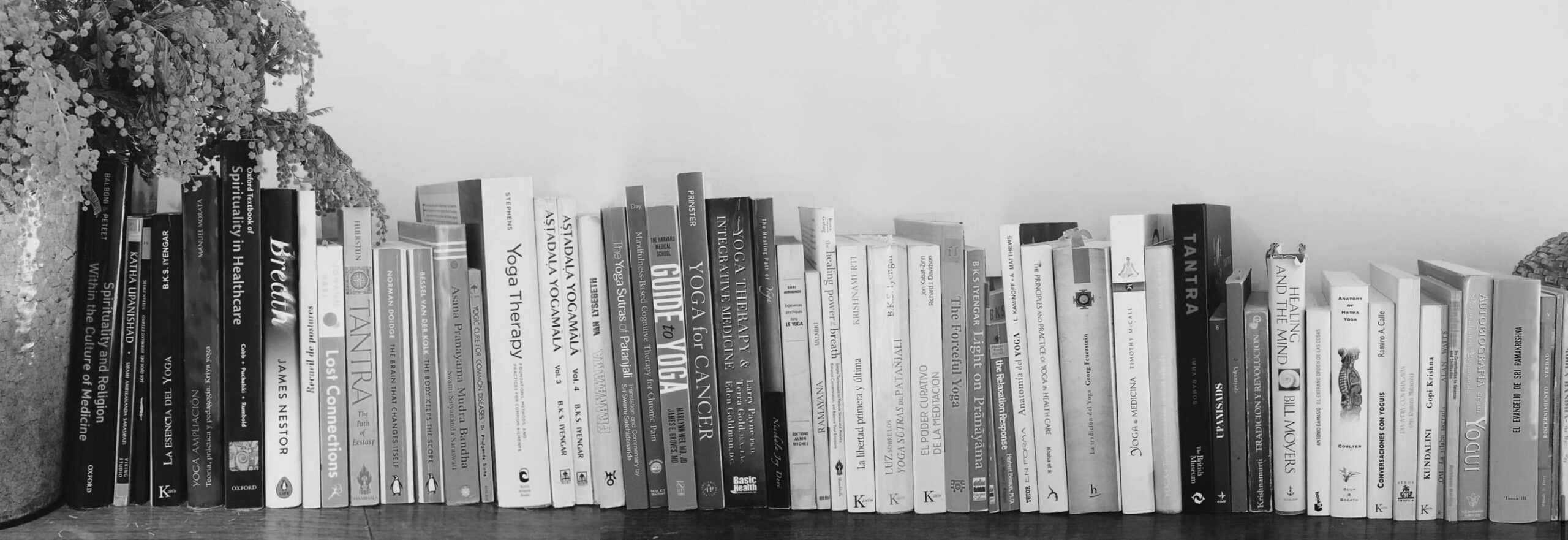Bhagavad Gita. Cantar del Glorioso Señor. Los pequeños libros de la sabiduría, 2005.
Balboni, M., & Peteet, J. (Eds.). Spirituality and Religion within the culture of Medicine: from evidence to practice, Oxford University Press, 2007.
Benson, H., y Klipper, M. Z., Relajación (The relaxation response), Morrow, 1975.
Block, K. I., Life over cancer, The Block Center program for integrative cancer treatment, 2009.
Iyengar, B.K.S., Luz sobre los sutras de Patanjali, Kairós, 2003.
Iyengar, B.K.S., La esencia del yoga , Kairós, 2007.
Iyengar, B.K.S., Light on Pranayama, Harper Collins Publishers, 2011.
Brown, R., & Gerbarg, P. Respire: El poder sanador de la respiración, Shambhala Publications, 2021.
Calle, Ramiro A. Principios de yogaterapia, Sirio, 1985.
Cheri, C. The Therapeutic Yoga Kit, Healing Arts Press, 2009.
Cobb, M., Puchalski, C., & Rumbold, B. (Eds.). Oxford textbook of spirituality in healthcare. OUP Oxford, 2012.
Cohen, L. Jefferies, A. (2019). Vida anti cáncer. Tranforma tu vida y tu salud a través de 6 elementos clave. Urano, 2019.
Coulter, D., Anatomy of hatha yoga: A manual for students, teachers, and practitioners. Body & Breath, Inc, 2001.
Gordon, James S., Transforming trauma. The path to hope and healing. Harper One. 2021.
Damasio, A., & Ros, J. El extraño orden de las cosas: la vida, los sentimientos y la creación de las culturas. Ediciones Destino, 2018.
Davis, D. M. The Beautiful Cure: Harnessing Your Body’s Natural Defences. Random House, 2018.
Day, M. A., Mindfulness-based cognitive therapy for chronic pain: A clinical manual and guide, John Wiley & Sons, 2017.
Leibel, L., & Pitman, A. (2022). Yoga Therapy Across the Cancer Care Continuum. Jessica Kingsley Publishers.
Eurich, T. Insight: The Surprising Truth About How Others See Us, How We See Ourselves, and Why the Answers
Matter More Than We Think. Currency. 2017.
Feuerstein, G., La tradición del yoga: Historia, literatura, filosofía y práctica. Editorial Herder, 1998.
Frankl, V., El hombre en busca de sentido, Editorial Herder, 2015.
Fueyo, J., Cuando el mundo se detiene, Sinequanon, 2023.
García-Grau E, Fusté-Escolano A, Bados-López A. Manual de entrenamiento en respiración. Barcelona: Facultad de Psicología, Universitat de Barcelona; 2011. págs.1-10.
Grané, J., Forés, A. La resiliència, UOC, 2007.
Joy Devi, N. The healing Path of Yoga, Abundant Wellbeing, 2000.
Kabat-Zinn, J. Vivir con plenitud las crisis: cómo utilizar la sabiduría del cuerpo y de la mente para enfrentarnos al estrés, el dolor y la enfermedad. Editorial Kairos, 2016.
Kaminoff, L. y Matthews, A. Anatomía del yoga. Tutor, 2013.
Khalsa, S. B. S., Cohen, L., McCall, T. B., y Telles, S. (eds.), The principles and practice of yoga in health care, SAGE Publications, Incorporated, 2017.
Katha Upanishad, Viking Studio, 2001.
Koenig, H., Koenig, H. G., King, D., & Carson, V. B. Handbook of religion and health. Oxford University Press, 2012.
Krishnamurti, J. La Libertad interior, Kairós, 1968.
Krishnamurti, J. La Libertad primera y última, Kairós, 1996.
McCall, T., YOGA y MEDICINA: Prescripción del yoga para la salud. Paidotribo, 2016.
Morata, M. Yoga. Teoría, práctica y metodología aplicada. 2006.
Muktibodhananda, S., Hatha Yoga Pradipika. Light on Hatha Yoga, Yoga Publications Trust, 2006.
Nestor, J., Breath: The new science of a lost art. Penguin UK, 2020.
Panikkar, R., Hinduismo. La experiencia védica. Mantramañjari. Editorial Herder, 2020.
Panikkar, R., Upanisads. Siruela, 1995.
Payne, L., Gold, T., y Goldman, E., Yoga therapy & integrative medicine: Where ancient science meets modern medicine, Basic Health Publications, Incorporated, 2014.
Ramos, I., Tantra: enlightenment to revolution, Thames & Hudson, 2020.
Reale, G., Antiseri, D., Historia del pensamiento filosófico y científico. Herder, 1995
Sapolsky, R. M. Why zebras don’t get ulcers: The acclaimed guide to stress, stress-related diseases, and coping-now revised and updated. Holt paperbacks, 2004.
Saraswati, S. S., y Hiti, J. K., Asana pranayama mudra bandha, Yoga Publications Trust, 1996.
Satchidananda, Sri Swami, The Yoga Sutras of Patanjali, Integral Yoga Publications, 2017.
Singleton, M., Yoga body: The origins of modern posture practice, Oxford University Press, 2010.
Stephens, M. Yoga Terapia: Fundamentos, métodos y prácticas para las enfermedades comunes, Sirio, 2019.
Timmins, F., & Caldeira, S. (Eds.). Spirituality in Healthcare: Perspectives for Innovative Practice. Springer, 2019.
Van der Kolk, B. A. (2015). El cuerpo lleva la cuenta. Cerebro, mente y cuerpo en la superación del trauma. Elefhteria. 2020
Van Lysebeth, A., y Tapia, S., Pranayama: a la serenidad por el yoga, Urano, 1985.
Vanistendael, S., y Manciaux, M. El realismo de la esperanza. Gedisa, 2004.
Wei, M., E. Groves, J. (2017). The Harvard Medical School Guide to Yoga. Lifelong Books.
Werner, E. E., & Smith, R. S. Journeys from childhood to midlife: Risk, resilience, and recovery. Cornell University Press, 2001.
Wittgenstein, L., Tractatus logico-philosophicus. Edicions 62, 1997.
Zysk, K. G. The science of respiration and the doctrine of the bodily winds in ancient India. Journal of the American Oriental Society, 1993, págs. 198-213.



